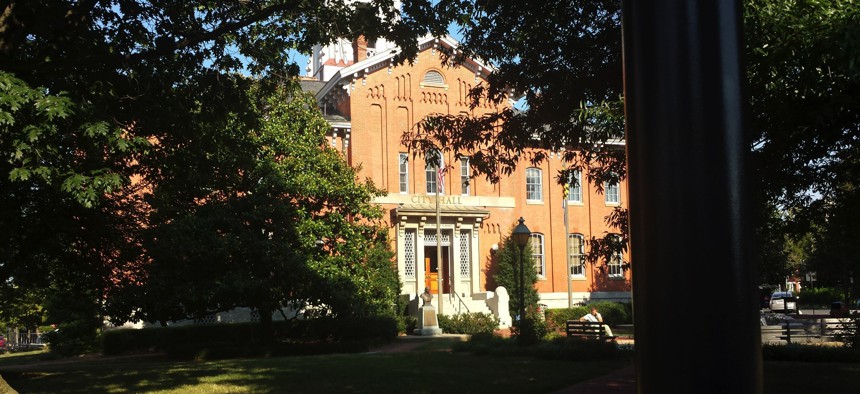Route Fifty City-County Roadtrip Recap: Should Frederick Remove Its Bust of a Pro-Slavery Historic Figure?

City Hall in Frederick, Maryland Michael Grass / RouteFifty.com

Connecting state and local government leaders
In this historic city, the legacy of the Civil War and slavery is front and center.
Route Fifty is currently featuring dispatches from a city-county summer roadtrip in Maryland, West Virginia, Pennsylvania, Ohio, Michigan and elsewhere along the way. An Introduction to the Series | Previous Stop: Baltimore
FREDERICK, Md. — City Hall in this historic city about 50 miles west of Baltimore sits a block west of Market Street, one of the main commercial thoroughfares, originally laid out in the 1740s. The seat of Frederick’s city government is housed in a red-brick structure originally built as a courthouse in 1862.
It’s a stately building with Italianate features—the historic core of the city is full of Federal-style rowhouses—and fronts a nice public park at the corner of Church and Court streets. City Hall is not a towering structure, but there’s a modest cupola.
Frederick’s skyline is dominated by church steeples. As I was venturing through downtown on my second pit-stop of my city-county summer roadtrip that Sunday morning, parishioners on Church Street were filing into the nearby twin-spired Frederick Evangelical Lutheran Church. The church has roots dating to the 1730s; the current structure was completed in 1855, which was used as a Union hospital during the bloody Battle of Antietam in 1862.
Civil War history looms large in this city. In July 1864, two years after the courthouse was built, Confederate Gen. Jubal Early held the city for ransom on his way to attack the nation’s capital in an ultimately futile assault. The general demanded a $200,000. And if the city didn’t pay up, his troops would burn down the city. City leaders were able to get five local banks to raise the necessary funding to pay off the general—a predicament that no city government would want be in.
But think of that $200,000, a huge sum at the time, as a good long-term investment for the city’s historic architecture, retail and restaurants that today draw tourists and others, including food-minded D.C.- and Baltimore-area residents looking for an close-by out-of-town escape.
The Civil War may have ended 150 years ago, but today in 2015, there are lingering battles over Confederate symbolism and racial inequity that we’re still fighting over as a nation.
Most recently, has been South Carolina’s decision to remove the flag of the Army of Northern Virginia, a commonly recognized symbol of the Confederacy, from the grounds of its Statehouse following the massacre at the Emanuel AME Church in Charleston. The national discussions sparked by the Charleston tragedy has prompted many state and local governments and public entities to reconsider the placement of Confederate symbols on public property.
At the University of Texas, for instance, an advisory panel recently recommended options for what do with statues of Confederate leaders on campus. Those recommendations involve relocating statues to a history center or adding plaques that add historical context, according to the Texas Tribune.
In Frederick, there’s a good example of putting a controversial historical figure in additional historical context with a plaque or other explanatory feature.

Outside City Hall, there’s a bust of Supreme Court Chief Justice Roger B. Taney, a Jacksonian Democrat who had once lived in Frederick and wrote the 1857 Dred Scott decision, which declared that slaves and freed slaves were not U.S. citizens, cannot become U.S. citizens and therefore couldn’t sue in federal court.
In 2009, the city of Frederick added a plaque adjacent to the Taney bust, with a history of the Dred Scott decision, adding historical context.
But as the Frederick News-Post reported earlier this month, Frederick Alderwoman Donna Kuzemchak has proposed relocating the Taney bust off City Hall grounds, a plan that attracted support at a recent meeting.
According to the News-Post:
Roger Wilson, the government affairs and public policy director for Frederick County, described it as a “step forward,” while resident Peter Samuel congratulated Kzuemchak on an action long overdue.
Samuel said Taney’s values directly conflict with the spirit and values of Frederick, both 150 years ago and today.
“Our hero was Barbara Fritchie, who defied the Confederates,” he said. “This man was an extreme Confederate and slavery supporter.”
Fritchie was a 95-year-old Frederick woman who was featured in a popular pro-Union poem penned by John Greenleaf Whittier that memorialized a defiant action that’s been widely credited to her: Flying an American flag outside a window as Confederate Gen. Stonewall Jackson’s troops marched through town. (You can check out the Barbara Fritchie House on Patrick Street.)
But as it turns out, Fritchie’s story is more complicated. The Washington Post reported in 2012 that “Fritchie’s fame sprang from poetic license run amok.” The woman who inspired “The Ballad of Barbara Fritchie” didn’t actually wave the American flag. That deed was actually done her neighbor, Mary Quantrell.
Revisiting history is definitely tricky.
Onward! Westward we go on Interstate 70!
Next Stop: Sideling Hill and the National Road
Michael Grass is Executive Editor of Government Executive’s Route Fifty.

NEXT STORY: Drought-Fueled ‘Self Deportation’ in California; Ashley Madison Hack’s Municipal Targets





